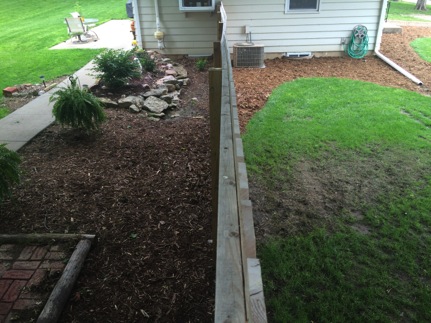(By Jake Reeves; KSU Turfgrass Research and Extension)
This spring, when the rains began to come, I started to notice a slight discoloration in my front yard next to my fence. The area was very shaded and has always struggled, so I thought nothing of it. However, as the weeks passed, the area became more defined with wilt and it was clearly showing itself as a “man-made” phenomenon.
Thinking back through my maintenance, there was only one thing that could have caused that shape and slow death: the herbicide I had sprayed uphill of the site to maintain bare ground weed control in my mulch.
The history… I developed a bad habit of maintaining empty large bed areas with bare ground herbicides when I lived on an extremely flat property at my last house. I hate weeding and the fewer applications I have to go out and make each year, the better.
I had used bare ground herbicides frequently at my job to maintain fence lines and other areas to cut down on weed eating due to a limited labor force. Over those few years I had little to no herbicide movement from the sites that I sprayed. That created a false sense of invincibility in my herbicide applications, which is never a good thing.
Fast forward to today… Unfortunately for my lawn, my property has a pretty hefty back to front slope and a lot of water moves over it when it rains. That means that my property is a prime area for herbicide movement and this spring has proved that.
So pay attention to your site and THE LABEL! Trying to cut corners will eventually come back to haunt you. Chemical companies put large amounts of money into researching for those labels to give you instructions so you don’t encounter these issues.
My lawn and my pride have paid the price for my undeserved hubris. Thankfully, given a little bit of time for the herbicide to break down in the soil and some grass seed later this fall, things should be repaired.
-Jake
Always remember to READ THE LABEL for the correct rate, turfgrass tolerance, and specific instructions before application!!!
***Mention of trade names or commercial products in this article is solely for identification purposes and does not imply recommendation or endorsement, nor is criticism implied of similar products not mentioned by Kansas State University.***


